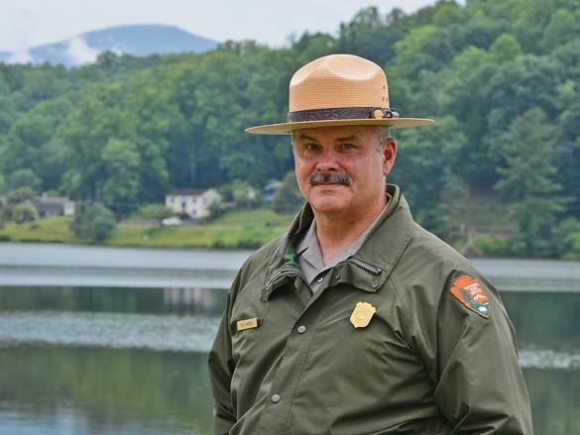A magical thing: Retiring Parkway superintendent reflects on 37 years with the Park Service

Mark Woods will retire as superintendent of the Blue Ridge Parkway on July 3, but on July 4 he’ll don the flathat one last time as grand marshal of the Lake Junaluska Fourth of July Parade.
“That was a surprise, to get that call,” Woods said. “We have family here, and every year there’s a family reunion that’s been going on for years at Lake Junaluska, so I’ve been coming here for as long as I’ve been married. To me this area is so special.”
Woods, 57, worked with the National Park Service for 37 years before making his decision to retire, positions ranging from resource management to law enforcement to superintendent. And while the concept of retirement seems “surreal,” he’s looking forward to spending more time with family — particularly his two grandchildren, ages almost-3 and almost-5 — and hiking the trails of Western North Carolina.
“I’m very thankful I’ve had a career I’ve absolutely loved and looked forward to going to work every day,” he said.
Every day is different
Woods was still in college when he started working for the Park Service, knowing he wanted to do some type of conservation work but not exactly sure what form that would take. He started out as a summer seasonal, doing resource management work at ninety six National Historic sites, and it didn’t take long for him to see a future with the national parks.
Related Items
“I loved it,” he said. “I realized the Park Service offered really so much you could do, from history to natural resource issues, firefighting, law enforcement, and I just realized it was a career I wanted to pursue.”
After resource management, Woods got into the Park Service’s law enforcement branch. He also held jobs in interpretation and education before taking his first superintendent post at Guilford Courthouse National Military Park, in Greensboro. From then, he went on to become superintendent at Virgin Islands National Park, Cumberland Gap National Seashore, Natchez Trace Parkway and, in 2013, the Blue Ridge Parkway.
In total, he’s worked at nine different parks, as well as a number of shorter-term detail assignments and stints as associate regional director and deputy regional director for the Park Service’s regional office in Atlanta.
“Every park is different, totally different, and every day is different,” Woods said. “You may be assisting a visitor one minute, and the next minute you’re dealing with a wildlife incident or dealing with search and rescue. It changes constantly, the activities you’re involved in.”
It’s a job that instills both gratitude for the present and awe of the past. Woods remembers a 1986 detail to the Statue of Liberty on Ellis Island in New York City, and the feeling of amazement at being able to see the history of the place in action. Or similarly, an assignment as chief ranger at the Andrew Johnson National Historical Site in Johnson City, Tennessee.
“Being able to work in the president’s home with all his stuff and his family items there was kind of surreal,” he said.
But the job wasn’t always about history. Often, it was about the moment at hand. Woods will always remember landing as part of a wildland firefighting crew in the tiny town of Salmon, Idaho, set to battle a blazing wildfire. The townspeople came out to meet them with posters and thank you notes and overflowing appreciation for what they’d come to do. Or, for a more peaceful moment, he’ll think of the time he and his family lived on Cumberland Island, an undeveloped piece of land off the Georgia coast, reachable only by boat.
“In some ways living right in the parks has been just a magical thing, almost,” he said.
While he’s lived in all types of parks doing all types of jobs, the superintendent posts have been the ones he’s enjoyed the most, and coming to the Parkway — and specifically, to Lake Junaluska — felt like coming home. Though Woods is from South Carolina, he has family ties at Lake Junaluska stretching back to the 1930s, with family members who still live in the area or at least come back for vacations. He and his wife plan to stay around after retirement.
Still work to do
The Parkway is unique among National Park Service units, and not just because of the rare habitats through which it passes or its status as one of the most-visited Park Service units, coming in second with 15.2 million visits in 2016. The Parkway is unique because of its string bean shape, with 469 miles of road spanning two states, 29 counties and countless cities and towns.
“It’s a seven-hour trip just to get to the other end of the park, and that’s if you take the interstate,” Woods said. “So that’s a huge difference. The second difference with this park I’d say are all of the communities. Every park has a community, but the Parkway touches so many towns.”
Understanding all the issues and meeting all the players in so many different localities spanning such a large geographical area is no easy task. Woods took a six-day trip this month traveling the entire Parkway toward that exact goal.
“One of my priorities was really to expand our influence and interactions with those communities, because they’re really the gateways to our park,” he said of his time with the Parkway.
For many of those communities, closed facilities were a big issue going into Woods’ tenure. In 2013, one-third of all Parkway facilities were closed, from restaurants to visitor centers to campgrounds. Some of those closures were due to federal budget sequestration — and some of them were due to lack of vendors. Various facilities throughout the Parkway are operated by private vendors, who work through contract agreements with the federal government. In some cases, Woods said, those contracts would end without any proposals obtained from new managers.
The work isn’t done. The Parkway still has its share of closed facilities. But there’s been substantial progress — on June 23, Woods cut the ribbon on the Doughton Park Visitor Center and Camp Store, which is near Laurel Springs and had been closed for seven years.
Last August, something else happened that was perhaps Woods’ proudest moment on the Parkway. The Park Service celebrated the addition of 5,329 acres to its land surrounding Waterrock Knob, the Parkway’s largest land acquisition in recent history. The Conservation Fund, The Nature Conservancy, the Southern Appalachian Highlands Conservancy and The Conservation Trust for North Carolina purchased the land and then turned it over to the Park Service.
Now, the next step is to plan for how that land should be managed — and it will be up to the next Parkway superintendent to see that process through.
“I think the key element will be really engaging with the communities around the Parkway,” Woods said — getting locals to help decide what will be the best long-term balance between ecological preservation and human enjoyment.
The next superintendent will also have to think about the upcoming generation, ensuring that those future park stewards develop and interest and passion for all that the national parks have to offer. Much has changed in the nearly four decades since Woods took his first Park Service job. Budgets are no longer tracked in paper ledgers, and guests are no longer satisfied with informational posters and static displays. Figuring out how to use social media and digital education tools to engage the public has been a challenge over recent years and will be a hurdle that the park must continue to overcome.
“If we can help people visiting the park understand the deeper issues facing the parks, we would have been successful as an agency,” Woods said. “In order to take care of something, you have to understand and appreciate it.”
Woods is hopeful that will happen. Following all the outreach efforts wrapped up in the yearlong celebration of the Park Service’s 100th birthday in 2016, visitation is up. While numbers peaked with 21.5 million visitors in 2002, counts diminished over the following years to 12.9 million in 2013, the year Woods joined the Parkway and the year the governmental shutdown closed facilities during one of the busiest parts of the year. Since then, numbers have increased to 13.9 million in 2014, 15 million in 2015 and 15.2 million in 2016. Visitation for the first four months of 2017 is 12.4 percent higher than the same period of 2016.
Woods saw those numbers illustrated during a recent interaction with a 5-year-old in Asheville. Seeing Woods in uniform, the boy came over and gave him a fist bump, running back to his mother for courage before returning to give the superintendent a big hug.
“It’s those kinds of things where you realize kids and young folks really do connect with all the parks have to offer,” Woods said.









